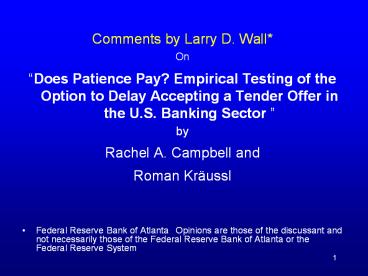Comments by Larry D. Wall* PowerPoint PPT Presentation
1 / 9
Title: Comments by Larry D. Wall*
1
- Comments by Larry D. Wall
- On
- Does Patience Pay? Empirical Testing of the
Option to Delay Accepting a Tender Offer in the
U.S. Banking Sector - by
- Rachel A. Campbell and
- Roman Kräussl
- Federal Reserve Bank of Atlanta. Opinions are
those of the discussant and not necessarily those
of the Federal Reserve Bank of Atlanta or the
Federal Reserve System
2
Overview of Paper
- Goal is to estimate the potential gain to target
shareholders of delaying acceptance of a takeover
offer for their bank - Method is to treat the potential for delay as a
real option. - The paper assumes initial takeover proposal takes
the form a tender offer - Shareholders then have the option of accepting
this tender offer or waiting to see if a better
one if it arrives - Thus, paper revolves around determining the value
of this real option
3
CommentsTender offer assumption
- The assumption that the initial takeover proposal
comes in the form of a tender offer is crucial to
use of option framework - Ordinarily the buyer of an option pays an up
front purchase price - Thereafter the buyer has no further risk of loss
- Tender offer is essentially a free option to
accept that offer or accept a better offer if one
arises - But in negotiated deals the target does not have
a firm offer until both sides agree to the
takeover - As a result the price in negotiated deals could
go up or down - Options pricing questionable for looking at
negotiated deals
4
CommentsTender offer assumption
- How common are tender offers in bank mergers?
- In my experience in US banking they are rare
- Tender offers frequently used in hostile takeover
situations - Hostile offers are very rare in commercial
banking - Vast majority are negotiated in my experience
- Implication is that delay is likely not a free
option in almost all bank takeovers
5
CommentFocus of the exercise
- Delay could result in an higher offer
- The intrinsic value of the target may increase
between the initial offer and the final offer - Later takeover proposals may propose a higher
premium over the targets intrinsic value - First potential acquirer could offer a higher
premium - Another potential acquirer could offer a higher
premium - The paper appears to examine only changes in
intrinsic value - Key parameter is volatility and this is estimated
directly which implies from historic data that
would be dominated by changes in intrinsic value
6
CommentsPeriod of time for option calculation
- The time to expiration (or maturity) of an option
is an important determinant of its value. - The value of the option monotonically increase
with its time to maturity - The paper calculates this time as
- the announcement and closing dates of the deals
were obtained in order to calculate the time to
maturity. - Procedure has errors on both sides
- Negotiations begin before the announcement
- This assumption appears to have the effect of
including all regulatory based delays in the
valuation
7
CommentTreatment of Dividends
- Dividends are treated as a cost of delay in the
real options model. The paper states - Dividends represent a cash-outflow of the
underlying asset that cannot be captured anymore
by the holder of the option and the value of the
option decreases. - This is certainly true if the shareholder and the
option holder are different people - But in this case the shareholder receiving the
dividend is also the person that has the option
to sell at a higher price - Hence its not obviously a cost of delay
8
SuggestionPaper Values Risk due to Lags
- The lag between time negotiations start and
consummation of takeover add risk to both parties - Target may increase in value benefiting target
shareholders and hurting acquirer - Or target may decrease in value which benefits
the acquirer at the expense of the target - Net cost if both parties are risk averse
- Relevance
- Target and acquire have incentive to minimize the
cost of the lags - Including negotiating when values are more stable
- Help measure part of the costs due to lags in
supervisory approval process (including DOJ)
9
CommentMinor comments
- Target SIC codes includes 6082
- The OSHA web site defines 6082 as Branches and
Agencies of Foreign Banks which do not seem
relevant to this study - What exactly is ST? Is ST known at time t or is
it a random variable? Given that the St is share
price before the acquirer made the tender offer,
the natural interpretation of ST is that it is
the share price in the market at time T, in which
case it would be a random variable.

